From Aggie
Horticulture, Texas A&M AgriLife Extension, Texas A&M
University
System
by Larry
A. Stein, Ph.D. and Julian W. Sauls, Ph.D. Professor and Extension
Horticulturists
Four-Flap Graft
The four-flap graft is an easy-to-do, highly successful grafting
procedure for both amateurs and professionals. It is ideal for
small-caliper trees up to an inch in diameter. The procedure is
sometimes called a "banana graft" because the four bark flaps not only
peel but also cover the scion much like a banana. This presentation is
adapted from an original Extension publication by Sammy Helmers and
Austin Stockton.
In this presentation, 22 images are used to
illustrate the finer points of the technique. Each image is presented
with the text as a thumbnail version for speed of downloading. Click on
the thumbnail image to see it as a full-screen version, then click
"Back" to return to the text and thumbnails.
Four-flap grafting
is most successful when the scion and stock are about the same
diameter. The best fit is obtained when the scion is slightly larger
than the stock. The best time to graft is April to May when the stock
is actively growing and the bark "slips" freely. Scion wood must have
been cut in January or February and placed in cold storage prior to
budbreak. The stored wood should not be allowed to dry out, or grafting
success will suffer.
Materials needed for four-flap grafting
include dormant graftwood, aluminum foil, polyethylene bags, a sharp
knife, budding tape, pruning shears, rubber bands and common household
glue. All of the equipment easily fits into an apron.
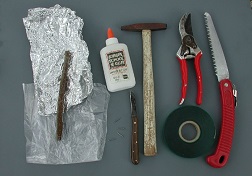
|

|
Fig. 1 
Common tools used in grafting |
Fig. 2 
Seedling pecan tree |
Select
a young tree with either its main trunk or a branch about one-half to
an inch in diameter. If livestock or deer are expected to be present,
the grafting height should be 7 or 8 feet above ground; otherwise,
select a comfortable working height. If there are side branches below
the point that you plan to graft, cut them back to about a foot in
length, as they will support the plant while the graft heals.
At
the point that you plan to make the graft, cut the top of the plant off
straight across the stock with sharp pruning shears. Wrap a rubber band
around the cut-off stock and roll it down the stock about 3 inches.
Make four straight vertical incisions through the bark of the stock,
each about 1.5 inches long and equally spaced around the stock.
Beginners may find it helpful to mark a cross on the cut surface of the
stock to show exactly where the vertical incisions must be made. Be
sure that the incisions completely penetrate to the underlying wood.
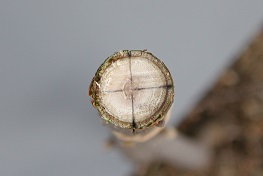
|

|
Fig. 3 
Stock marked for the vertical cuts |
Fig. 4 
Side view of vertical incisions |
Separate
the bark flaps from the wood briefly to assure that the bark is
slipping, then slip the rubber band up onto the bark flaps to hold them
against the stock and prevent drying while the scion is being prepared.
Select
a smooth, straight graft stick of the appropriate diameter and about 6
inches long. It should have two or three plump buds on the upper half.
Cut off about half an inch of the base of the graft stick to assure
healthy green tissue. If the wood is brown or shriveled, indicating
dryness from improper storage, do not use it.
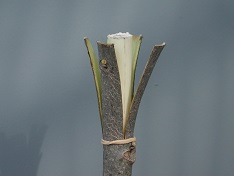
|
 |
Fig. 5 
Bark flaps pulled away |
Fig. 6 
Comparison of stock and scion sizes |
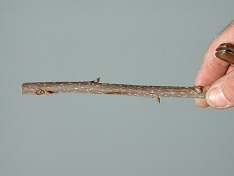
|
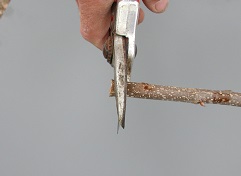
|
Fig. 7 
Typical pecan graft stick |
Fig. 8 
Cut off the base of the graft stick |
With
a sharp knife, cut the graft stick on four sides, starting about 1.5
inches above the basal end and slicing towards it. Before attempting
this for the first time, look at the images showing both side and end
views of the prepared scion so you will know how the finished scion
should look. Basically, the cuts will create a square-shaped end , with
four inch-and-a-half long, thin slivers of bark (and cambium) remaining
at each corner.
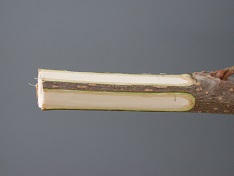
|

|
Fig. 9 
Side view of the prepared scion |
Fig. 10 
End view of the prepared scion |
Now
that the scion is prepared, roll the rubber band back down on the stock
so that the bark flaps can be pulled down. Some propagators find it
helpful to pull the flaps down against the stock and hold them there by
rolling the rubber band up on them. Either way, carefully position the
pruning shears and cut off the upper 1.5 inches of the exposed stock
without damaging the four bark flaps.
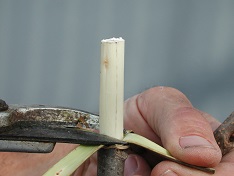
|
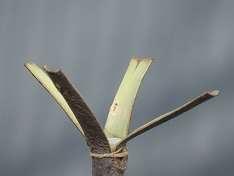 |
Fig. 11 
Preparing to remove the stock top |
Fig. 12 
Stock ready for insertion of the scion |
Place
the prepared scion upright on the stock, pull the four bark flaps back
up against the scion and roll the rubber band up onto the flaps to hold
them and the scion in place. Be sure that the thin slivers of bark on
the scion are situated in the openings between adjacent flaps of the
stock-if not, gently twist the scion until they are.
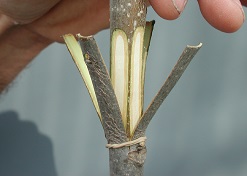
|
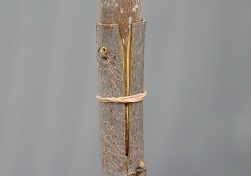
|
Fig. 13 
Orientation of the scion on the stock |
Fig. 14 
Flaps closed with rubber band |
Wrap
the entire cut area of the stock and lower part of the scion firmly
with budding tape, floral tape or other suitable material that
stretches. Neither masking tape, packing tape nor electrical tape are
adequate. Be careful not to twist the bark flaps as you make the wraps.
Wrapping is started at the bottom, each turn overlapping the previous
one until all cut surfaces are covered. Secure the end of the tape by
tucking it under the last wrap before you pull it tight. Some
propagators prefer to wrap to the top, then wrap back down, but such
double wrapping is not absolutely essential with strong budding tape.
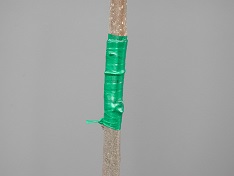
|

|
Fig. 15 
Securely taped graft |
Fig. 16 
Aluminum foil in place |
Cut
a piece of aluminum foil to the appropriate size and loosely cover the
entire taped area, crimping it slightly to compress it around the graft
and hold it in place. Aluminum foil will reflect sunlight and prevent
the graft union from getting too hot.
Cut off one corner of a
pint or quart polyethylene freezer bag and carefully slip it down over
the graft, with the scion protruding through the cut-off corner of the
bag. Be extremely careful not to break off the scion buds while this is
being done. Tie the cut-off corner of the bag to the scion at the top
of the aluminum foil wrap, below the lowest bud on the scion. Then tie
the lower part of the bag firmly around the stock near the lower edge
of the foil wrap. In both cases, the ties should be atop the foil, as
no exposed wood should be covered by the bag. These ties should be with
budding tape, rubber band strips or other material that will stretch.

|
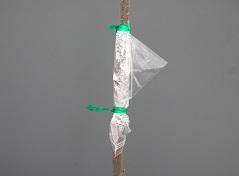
|
Fig. 17 
Bag positioned over graft |
Fig. 18 
Bag secured top and bottom |
Coat the tip of the scion with a dab of glue to prevent its drying out
while the graft heals.
Generally,
the buds on the scion will begin to grow in 3 to 6 weeks. All wrapping
materials should remain in place for another 4 to 6 weeks after the
scion buds begin to grow, at which time the ties, the bag and the foil
may be removed.
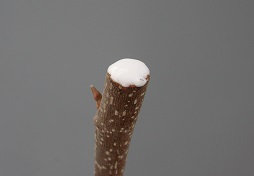
|
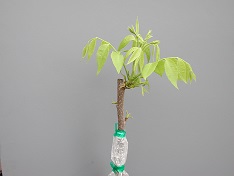
|
Fig. 19 
Scion end covered with glue |
Fig. 20 
Early growth of the scion buds |
In
addition to the growth of the scion buds, a number of buds along the
stock will also grow. To aid in the recovery of the tree, these shoots
on the stock should be maintained, but they must be kept pruned back to
preclude their overgrowing the new scion. The simplest means to control
them is to pinch off or cut off their tips periodically as necessary
during the rest of the season.
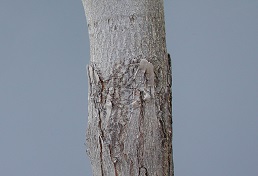
|

|
Fig. 21 
Completely healed graft |
Fig. 22 
Growth of the new tree |
Healing
of the graft union is quite rapid as compared to some other grafting
methods. You can easily distinguish the union by noting the different
appearance of the bark of the stock and the scion. After 2 or 3 years,
the trashy branches along the stock should be completely removed. Too,
the scion should be trimmed to leave only one single, strong shoot to
develop into the new tree.
Publication from Aggie Horticulture®
The information, as it is presented on this Website, does not represent
an endorsement
by the State of Texas or any State agency.
Further
Reading
Four-Flap Grafting of Pecan Trees, Mississippi State University Extension pdf
Back to
Grafting
Techniques Page
|
Publication from Aggie Horticulture®
|





















